M. King Hubbert has a rare distinction among prophets: first they ignored him, then they laughed at him, then they fought him, then he won.
And then he lost.
From 1860 through the mid-50s, US oil production followed a smooth exponential curve. (I don’t mean “exponential” as in “growing really fast” — I mean that 8.027e^(0.0771*years since Colonel Drake drilled the well at Titusville) gives you a curve that fits US annual barrels per day with an r-squared of .97.) But there are many curves that can fit a given time series, and Hubbert argued that the best fit for oil production was closer to a bell curve.
Here’s what an exponential model would have looked like at the time that he made his prediction — a log chart obscures the magnitude of the 1950s divergence, but as you can see an exponential curve gives a very close fit:
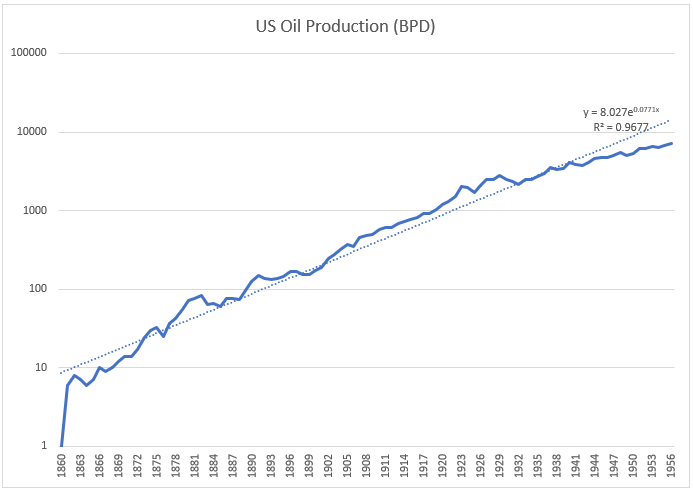
And here’s what happened next (not log-scaled)[1]:
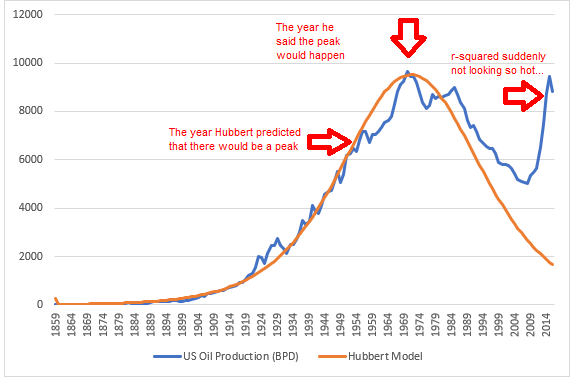
Hubbert’s prediction was one of the all-time greats: he predicted the peak of what seemed like an unstoppable trend, and nailed the date to within a few years despite everyone in the industry telling him he was wrong.
And then, something changed.
You start to see deviations from the trend almost as soon as the peak happened, but there have been deviations before. During the Roaring 20s, when auto sales rose from 1.4m in 1920 to 4.0m in 1929, and new discoveries in Oklahoma, Louisiana, and California produced unprecedented volumes of oil, production was above trend. In the late 1950s and early 60s, Hubbert appeared to be a little too optimistic. But generally, Hubbert’s curve approximated US oil production (with a little wiggle room due to Prudhoe Bay in the 80s) — until the 2010s, when the trend suddenly, violently reversed. US oil production has grown at a compound annual rate of over 6% in the last ten years. The last time we saw growth rates like that was in the 40s, and the only country whose oil output is growing faster in percentage terms is Iraq.
For the peak oil thesis, recent US production statistics are somewhere between a major problem and a mortal blow. And peak oil skeptics had the theoretical ammunition at hand.
The strongest counterargument against the peak oil framework has always been some variant of Hotelling’s Rule. Hotelling made a simple calculation: anyone who owns a natural resource will want to maximize the net present value of that resource. If they think prices will rise in the future, the optimal move is to defer extraction; if producers believe prices will fall, they should extract now. If the quantity of the resource is known, the rate of price growth will roughly match the rate of depletion, so production should decline at a steady pace.
There are a few kinks that make it hard to directly apply Hotelling’s Rule:
- New discoveries increase the future available supply. If you own oil today, and you expect more fields to be discovered next year, you want to pump immediately.
- On the other hand, some resource owners have a higher discount rate, so they have an incentive to pump faster. For example, if you’re tenuously in control of an unstable country, you might pump as much oil as possible and keep a gassed-up Cessna on hand at all times to fly you to Switzerland in the event of a coup.
- And on the other-other hand, if you’re a supplier, you might think that volatility encourages buyers to switch to other resources. If oil is more volatile than coal, a coal power plant with a lower absolute return than an oil-based plant might generate a superior risk-adjusted return. So large suppliers have an incentive to raise and lower production to manipulate prices towards a more stable equilibrium.
Throughout the history of the oil industry, there have been cartels that tried to reduce the volatility of oil:
- Rockefeller monopolized refining in the 19th century, and sometimes used above- or below-market crude purchases to control volatility.
- The “Seven Sisters” had a lock on oil, and agreed to quotas starting in 1928.
- Texas Railroad Commission (call them OPEC: the Organization of Petroleum Exportin’ Cowboys) suppressed US extraction activity in the 50s and 60s, before finally giving in and allowing unrestricted production in 1972, two years after US production peaked.
- OPEC generally controlled production thereafter, but by the late 2000s they had little excess capacity.[2]
If you want to split them into more philosophical camps, the two oil price theories are vague optimism or certain pessimism. On one side, the economists will say that expensive oil is a massive subsidy for oil exploration. On the other side, the engineers say that there’s a finite amount of oil in the ground, and no amount of money can send more algae back in time to get squeezed into hydrocarbons. Oil discoveries peaked in the 60s, and while price changes make some oil economical to extract, they don’t generate any more oil.
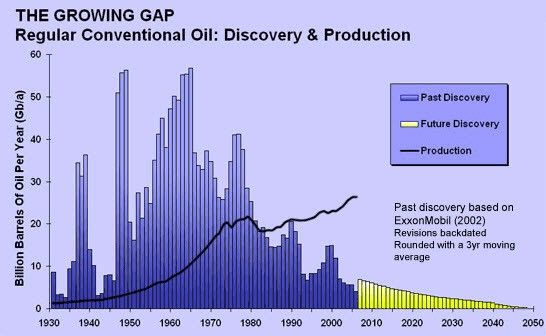
From 1970 through the 90s, the engineers were winning. Domestic oil production peaked, and high prices didn’t lead to more US discoveries. Internationally, production peaked at different times in different places (Nigeria: 1979, UK: 1999, Norway: 2000)The global Hubbert Peak can be considered the sum of a series of different Hubbert curves, most of which had a midpoint later than 1970, but all of which have a midpoint. Since 2010, the economists appear to have been vindicated: oil got expensive, so we got better at extracting oil. Now the debate is not over how to wean America off of oil, but over when we’ll reach net-exporter status.
Fracking: What Kind of Engineering Miracle?
In 1997, the equation for American hydrocarbon production changed when George Mitchell successfully fracked a gas well. The old approach was high-risk exploration, after which a field would have fairly low breakevens for a long, long time. Now, the durations are shorter, and there’s more certainty, at the cost of lower margins. In traditional investing terms, the math switched from venture capital-like returns (power law distribution of results, with a few winners dominating many losers) to private equity-style (more certainty, with lower returns on assets from winners, juiced by higher leverage).
It’s debatable exactly why this happened. One reason is just market-driven: oil prices were low in the late 80s and throughout the 90s, so companies didn’t have an incentive to invest in new production methods. Prices rose in the 2000s, due to emerging market more than offsetting slow supply growth, as well as disruptions like the war in Iraq, and these higher prices gave oil companies more incentives to test new methods. And there’s a cultural dynamic at play: the long generation that had faced a decade or more of low returns slowly retired, and people new to the industry were more risk-tolerant.
And then there’s the financial side: fracking bulls and fracking bears do not debate one part of the fracking story: it’s a story about American companies leveraging their superior access to risk-tolerant capital. Aubrey McClendon, the late founder of Chesapeake, was a case in point. He built a fracking behemoth, not on the basis of superior operating economics, but on the basis of being able to raise enormous sums in the equity and high-yield markets (from 2001 to 2012: $15.5bn in debt and $16.4bn in equity, paying $1.1bn in fees along the way, according to Bethany McLean’s Saudi America). He also had a knack for engaging in complex financial deals to keep the operation going. As long as money was flowing, capex was flowing, and as long as capex was flowing, the hydrocarbons were, too.
Other frackers also depend on continuous flows of capital. There’s a case to be made that this is optimal: since fracking is still a developing technology, they can expect their cost to trend down over time. But the only way to learn how is by doing. In that sense, they’re not just extracting oil; they’re drilling for know-how as well. Of course, we don’t ultimately know how far we can push the cost curve, nor do we know what the effective depletion rate of fracked oil is in the presence of so many frackers: to paraphrase There Will Be Blood, frackers may be blasting a slurry of water and proppants into one another’s milkshakes without knowing it.
So both the bull and bear theses argue that frackers will need large amounts of capital, with suboptimal returns, at least for now. The bull case is that some amount of this capital will retroactively constitute R&D expense, to be amortized over profitable wells for decades to come. Bears will argue that the fracking business is structurally difficult — that “unconventional” oil is and always will be a euphemism for “expensive” oil, and that the absence of low-hanging fruit will offset any expected improvements in the economics of fruit-picking.
Both sides believe that fracking is a triumph of at least one kind of engineering; optimists say it’s two.

So, regardless of your belief about the long-term economics of fracking, you’ll believe that the short-term economics rely on a continuous flow of outside capital.
This creates a unique dynamic. Historically, the swing producers of oil were not seriously capital-constrained. Saudi Arabia has enormous reserves and a comically low breakeven point. Their close relationship with the US offers them more stability than your typical Middle Eastern government might expect. So they can operate close to the Hotelling optimum: when oil is expensive, they pump; when it’s cheap, they don’t. There’s no point at which oil could be expensive but they’d be somehow unable to get it out of the ground. The closest they came to that was when Saddam Hussein invaded Kuwait, which demonstrated that he could go after Ghawar next — and the US promptly made it clear that Saudi control of Saudi oil was America’s top strategic priority. Other major producers are in a similar situation; they’re either state oil companies with access to government capital, or large, conservatively-run blue-chip enterprises that can pay for growth out of their internal cash flows.
The high capital cost of fracking, coupled with faster depletion, has changed the financial profile of oil production: as long as there’s high-yield capital available, oil assets are shorter-duration. And duration is one of those risks investors get paid for — in other words, lower durations lower the required rate of return.
The Microeconomics of Fracking: Supply Elasticity and Credit Spreads
Prices are the point at which supply meets demand. Historically, both supply and demand have been prone to shocks. On the supply side, shocks tend to be immediate: a new field gets discovered, or an existing field gets disrupted for political reasons. On the demand side, shocks are more prospective: the reason prices plummeted in 2015 was that investors have previously extrapolated forward higher rates of developing-world growth. In 2014, markets outside the North America and Europe were 64% of consumption but 106% of the last ten years’ consumption growth, so a lower growth rate compounded over several years produces a meaningfully lower current price.
At the same time, supply is somewhat sticky: a given oil well lasts for a long time (between 20 and 30 years, on average), so increases in supply persist over time.
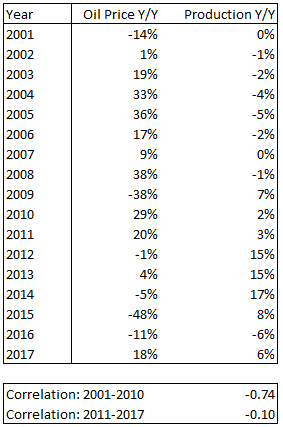
Oil prices still respond to supply more than supply responds to oil, but the relationship isn’t as perversely negative as it used to be.
Fracking changes this dynamic, because it’s largely about extracting known amounts of oil that used to be uneconomic. It’s relatively easier for US suppliers to meet demand.
Fracked wells tend to deplete faster than conventional wells, so there’s an additional level of flexibility: merely maintaining production requires high ongoing levels of capital expenditure, whereas conventional producers can cut capex and still produce economically. Essentially, the rise of fracking makes capex closer to being a marginal cost.
Using a toy model ($10 marginal cost, $250k/year fixed cost, ~200k barrels of oil produced in year one, 10% annual decline rate for conventional and 50% for fracked), we can estimate the duration of a well’s cash flow streams. This is duration in the financial sense of how many years it will take for the well to produce half of its lifetime net present value. Under this model, a conventional well’s duration ranges from 7 years at $30 oil to a little over 8 at $70. For a fracked well, duration is 1.6 years at $30/bbl and 1.8 at $70.
The net result: when conventional producers are producing below capacity, fracking doesn’t have much of an economic edge, but fracking responds to price changes on a far shorter lag.
The result:
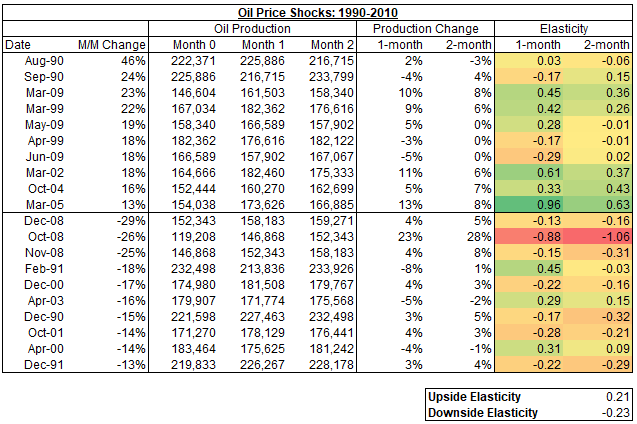
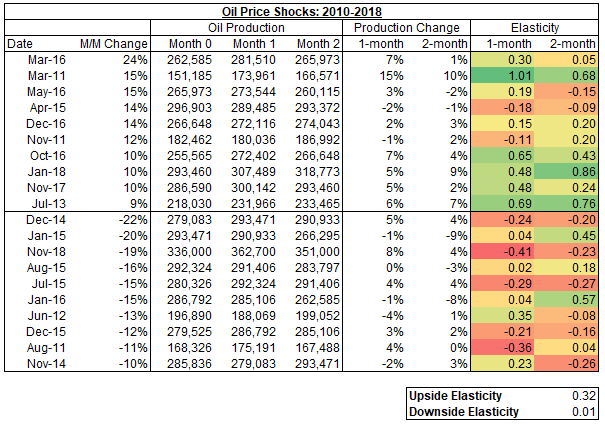
We see that upside and downside elasticity, while low, have improved despite larger scale — incremental productive capacity is, in fact, more responsive to changes in price.
The Macroeconomics of Fracking: Monetary Flexibility (Unless You Really Need It)
Oil plays an outsize role in economic policy: it’s consumed everywhere, but not produced everywhere, and the price is volatile, so big swings in oil prices tend to affect currencies and central bank policies. We saw this most vividly in 2008, when the Fed refused to cut rates the day after Lehman failed, on the grounds that high oil prices presaged more general inflation. Traditionally a country is viewed as economically independent if its debts are denominated in its own currency, because it can inflate them away. But an oil-dependent oil importer has a large debt denominated in oil, which is more volatile than any major currency.
Historically, oil has played a large role in our economic policy because it’s been a significant component of the US trade deficit.
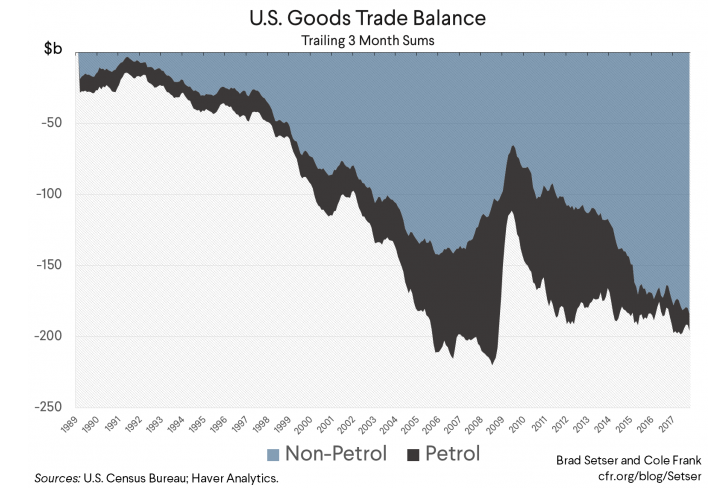
Fracking changes the macroeconomic math, in a way that benefits the dollar and thus gives the Fed more flexibility in mitigating global oil supply shocks: when oil prices rise, domestic oil production is more sensitive to prices than it used to be, so it can rise in response. This means that higher oil prices don’t lead to as much of an increase in the trade deficit, so they’re not as harmful to the dollar. And there’s a second-order currency effect as well: since higher oil prices increase the number of viable dollar-denominated investments that can be funded by high-yield bonds, they should increase foreign investment in US assets. Because of these twin dynamics, we’ll reach the point where high oil is positive for the dollar before we reach the point where we’re a net oil exporter.
That is, we will as long as credit spreads are tight enough that fracking is economically viable.
This creates a fascinating inversion of the run-up to the crisis. In the mid-2000s, high oil prices didn’t exert the expected negative effect on consumer spending. Normally, an increase in gas prices is a tax on consumption — statistically, US oil consumers’ price elasticity with respect to changes in oil prices is around -0.06 (i.e. it takes a 16% change in oil prices to produce a 1% decrease in short-term consumption — an orders of magnitude lower sensitivity than we see with things like food products). So typically, a rise in oil prices should produce a drop in the consumption of other goods and services. In the mid-2000s, it didn’t.
The reason for this was that high oil prices increased exporters’ surpluses, but most of the exporters didn’t allow their currencies to appreciate in response. Instead, they accumulated dollars, sold some to diversify their currency exposure, and invested the remainder in higher-return assets. At the time, the best way to juice one’s dollar returns at low risk was to invest in mortgage-backed securities.
And this was also the era of high real estate prices and mass refinancing. (As I noted in my mortgages piece, US consumer cashed out $966bn from 2004–2007 — the total increase in US consumer spending over the same period was around double that, i.e. about half of all incremental consumer spending growth was from people using their houses as ATMs) For a while, the following conditions held:
- Housing prices were highly responsive to incremental capital flowing into mortgages.
- Capital from oil exporters flowed into mortgages (and also into other forms of less-than-riskless debt, such as the debt underpinning large leveraged buyouts).
- US consumers were, in the aggregate, willing to smooth consumption by monetizing their home equity — the wealth effect from real estate appreciation offset the spending drag from gas prices — so
- Higher oil prices didn’t slow consumption — they just lowered credit spreads and thus raised leverage, and the resulting gusher of liquidity actually raised consumption.[3]
Now, we see the same forces, with the causation reversed:
- Low credit spreads lower the duration of oil investments in the US, increasing the elasticity with respect to price
- So higher oil demand quickly matches supply, keeping economic growth stable
- Stable economic growth leads to more willingness to take risks, increasing investors’ willingness to buy high-yield debt
- The combination of US production offsetting consumption, and higher demand for USD-denominated corporate debt, puts upward pressure on the dollar, giving the Fed more flexibility
Or, put another way, the old paradigm:
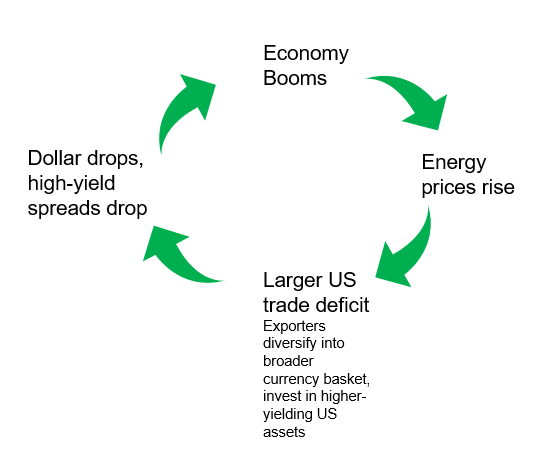
…Becomes…
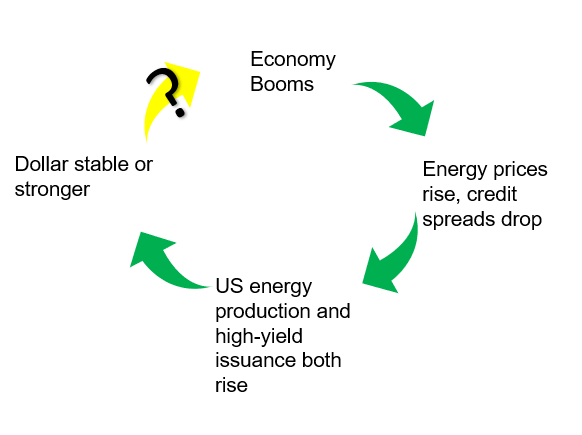
There’s a counterargument about energy independence and its impact on the US balance of trade, best articulated here. It holds that since higher oil exports will raise the dollar, they’ll hurt other exports and benefit other imports. In other words, it assumes that the US propensity to save less than we invest, such that foreign exporters make up the difference, is the real driver of our deficit. But surely, petrodollar recycling is one of the drivers of that gap. Even if oil exports per se don’t lower our deficit long-term, fewer dollars in the hands of countries that accumulate American assets should.
While the US trade deficit’s sensitivity to oil exports isn’t 1:1, it isn’t zero, either. In the current status quo, fracking means that the marginal impact of higher energy prices should not flow directly into higher deficits; by moving oil production back to the US, and shortening the duration of oil investments, we’ve tamed that beast.
But just like in the mid-2000s, it’s a status quo that works until it doesn’t.
What could break the cycle? There are a few candidates:
- Current low oil prices could persist, causing more frackers to go out of business
- Low oil prices could also slow the rate of improvement in fracking ROI, making investors less willing to front frackers the money
- Inflation ex-energy could lead to higher rates, reducing the relative attractiveness of high-yield debt[4]
- We could see a faster decline in the performance of fracked wells. An oil services company recently pointed out that the Permian Basin, the main source of fracking supply growth, is seeing declining performance per well:
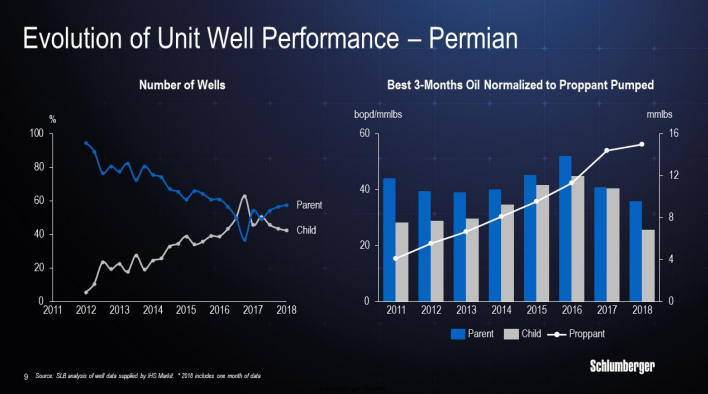
We haven’t had a real test of how the current economy would respond to a sustained increase in both rates and credit spreads, much less a decline in fracking output. The last time credit spreads blew out, frackers were the culprit: when oil prices collapsed from late 2014 through early 2016, there was a wave of bankruptcies across the energy sector — but the drop in oil prices was a dividend for consumers, who responded by spending it.
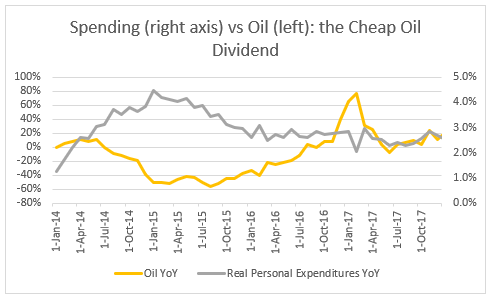
The Financial Theory of Oil
It doesn’t make sense to talk about oil price without talking about volatility as well. I recommend Crude Volatility for a great historical overview, coupled with some theory.
What I’d like to focus on here is the fact that we should expect oil volatility to correlate positively with price. For conventional onshore oil producers, and for people who own oil directly, this implies positive convexity: the higher oil goes, the faster it moves.
Normally if there’s a correlation between an asset’s price and its volatility, this implies that the most favorable investment is the one with the most optionality. And you can naively model an oil company as a series of call options, whose strike price is the price of extraction. So Saudi Aramco is a portfolio of deep in-the-money options on Ghawar and other giant fields, while a more speculative company with lots of tar sand leases might be modeled as a portfolio of call options with strike prices in the $50-$200 /barrel range— close to worthless now, but with massive upside when prices rise.
It’s not so straightforward, for two reasons: First, as mentioned before, the alternative oil producers tend to be capital-intensive, and to rely on high-yield financing, and we’d expect that in a world of more expensive oil, high-yield spreads will be higher. Second, the cost of oil service equipment also varies with the amount of drilling we’re doing. In call option terms, as the price of the reference asset rises, the option’s strike price rises, too, albeit at a slower rate.
Another consideration is energy intensity itself. In addition to measuring the financial ROI of an investment, some academics look at the energy ROI, i.e. for a given amount of energy extracted, how much energy must be consumed? To extract oil, you need to use oil: you have to power the vehicles and equipment somehow.
Overall, there has been a secular decline in energy ROIs for most fossil fuels over time: while we’re getting more efficient in an all-else-equal sense, all else is not equal because we deplete the easy stuff first. The EROI for US oil and gas, for example, declined from over 20:1 in the 50s (burn ~one barrel of oil for every ~20 you get out of the ground and refine) to around 10:1 in 2007, according to this survey. And the EROI for fracking and tar sands is around 4:1.
Frackers are not the only high-cost, high-risk source of energy. Offshore oil has somewhat similar cost economics, with a higher fixed cost and higher marginal cost that only makes economic sense when pricing is high. Since we have less information on offshore than onshore opportunities (more of the world’s land surface has been mapped and prospected, compared to ocean sources), a shift towards offshore production should further increase volatility.
Finally, there’s a geopolitical element. As a Brookings Institution report notes, “Oil remains the world’s most efficient mechanism for translating economic into geopolitical risk.”[5] Many of the countries with ample oil supplies are either unstable or are actively opposed to US interests. As oil prices rise, we can expect to see political unrest among importers (we saw some of this during the commodities boom of 2008), and greater foreign policy ambition among exporters. China (currently the largest net oil importer) is a particular concern: while the US views oil as a global market, China views it as a strategic asset — they’re right to think this way, because oil is only “global” due to cheap ocean transportation, and ocean transport is only cheap for shippers because the US navy spends about $50bn/year defending the major shipping routes. In foreign policy, high energy prices raise the stakes, and some heads of state can’t resist a gamble.
This implies that frackers’ operating costs will see nonlinear upward pressure at exactly the time when their revenues are seeing the same:
- Higher oil prices imply more economic uncertainty, raising their cost of capital.
- The cost of capital further ratchets up because of the correlation between price and volatility; high oil prices are less stable than low, and lenders care more about downside than upside.
- Geopolitical uncertainty also raises the cost of capital, albeit less in the US than in other markets. This effect is mixed. If risk-seeking capital is especially averse to the risk of war, then war means that capital flows towards the US. But total investor risk aversion will be higher at a time of conflict. If the impact on overall risk-seeking is greater than the impact within the pool of risk-hungry investors, the net effect is less available capital for risky endeavors.
- As prices rise, the energy cost component of extraction will be increasingly dominant. The prices for other inputs will rise as well, which hurts lower-margin players the most.
- A high-price world is also a world where more low-hanging fruit has been picked, raising their risk and their energy cost — so both the operating-cost problem and the financing-cost problem compound.
The only saving grace they have is the lower duration of their assets. High volatility has a disproportionate effect on out-year expectations, but since their revenues accrue more immediately, this is less of a problem.
Overall, though, we can conclude that frackers will benefit less from extreme price movements than a naive financial model would imply. While their revenues will rise, their operating and financial costs will rise, too. In a fracking-heavy world, high-yield debt becomes a reflexive asset: when yields rise, the economy becomes more sensitive to energy shocks, increasing risks and causing yields to rise further. The fact that cheap oil bankrupted some frackers doesn’t mean that the circumstances surrounding expensive oil couldn’t bankrupt them, too.
There is no Status Quo
The two sins in economic analysis are blind faith in extrapolation and blind faith in mean reversion. Either one can work for a while, but reality eventually prevails. Technological progress and natural resource depletion both represent non mean-reverting changes to fundamental drivers behind economic trends.
If we assume that the growth in domestic oil production from the 2010s onward represent a new status quo, we’re benefiting from a newly stable macroeconomic regime, where the Fed has more flexibility to respond to challenges without being derailed by short-term volatility in commodity prices. But if the rise of fracking is just borrowing oil consumption from the future to reduce volatility in the present, we’ve magnified our problems. At current high-yield spreads, we’re paying payday-lender rates to enjoy consumption now, but the bills will still come due.
Neither Hotelling nor Hubbert perfectly explain the status quo, but they’re both good models to start with. From the Hubbert perspective, you can treat fracking as a small upside surprise to the total amount of oil available, but one that shifts the peak rightward, rather than eliminating it. From a Hotelling perspective, consider the variability in discount rates for different oil extractors: when supplies are abundant, the marginal producer is someone who expects their assets to be expropriated, but over time either a) the instability they’re worried about comes to fruition, and political chaos prevents any oil extraction (Venezuela and Libya today, Iraq in the mid-2000s, Russia after the collapse of the Soviet Union), or b) over time, production shifts towards countries with strong property rights — as politically risky oil gets depleted, cheap financing matters relatively more than favorable geology. As is often the case, both models are wrong, and both are useful.
I haven’t had a consistent opinion on peak oil. When I first heard about it ten years ago, with oil hitting new highs every day, it struck me as self-evidently wrong. Surely higher prices are a self-correcting problem! But now, at a time of lower oil prices, it actually seems more compelling: higher prices corrected in the laziest possible way, and supply and demand elasticity only look slightly better than they used to.
In Crude Volatility, Robert McNally shows that oil has gone through high- and low-volatility cycles. When there’s excess capacity, swing producers hold production back in order to reduce price swings. When we reach peak capacity, prices swing more. Paradoxically, this makes oil’s record-setting drop from 2014–16 evidence for peak oil; you don’t see unstable equilibria like that when somebody could have opened the spigot a little bit in 2014.
Visually, McNally represents it like this:
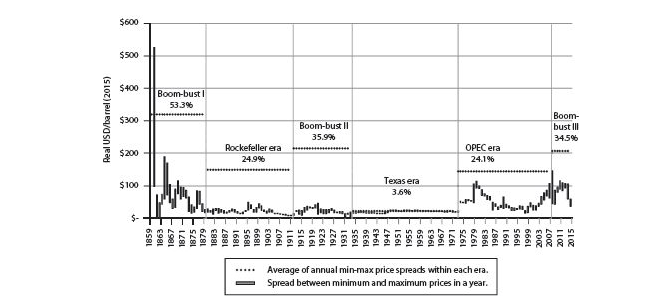
On the demand side, the evidence is also strong that the economic argument isn’t winning. Sure, fuel efficiency in the US has improved, but vehicles’ useful lives have gone up, too, so the market’s ability to respond to incremental price swings has gone down. And it’s not as if we have a good shot replacing car commutes with other alternatives. The MTA makes $200/barrel oil look affordable. Although in fairness to my home team, at least we’re better than California, where the light rail project is ~2x over budget so far (I’ll take the over) and not expected to be done until 2033 (I’ll take the over again).
The economic thesis depends on substitution, but we as a country are either unable or unwilling to substitute. And if a product has a buyer at any price, the price will be set entirely by supply.
For now, fracking makes things superficially okay. But the fundamentals have changed; instead of a cash flow-positive cartel controlling supply growth, we have a cash flow-negative industry sector. That puts us closer to the boom-bust paradigm than the various stable eras — and the current “bust” status doesn’t change those fundamentals.
Since 2016, America has found itself in an odd position: we had economic growth coupled with low oil prices, due to an unprecedented increase in domestic oil production. After decades of declining oil output and rising imports, it was a wish come true. If you find yourself the protagonist of a story where your wishes are granted, it behooves you to figure out whether you’re in a happy cartoon, or dark folk tale with an important moral lesson at the end.
(Or a dirty joke.)
Further Reading
- The Boom is a good overview of the industry. Saudi America was kind of disappointing; fairly brief, poorly-edited, not a ton of new information, but it does articulate the financial engineering thesis of fracking.
- For more on petrodollar recycling and its effects on risk premia, I recommend either a) reading this, b) scrounging up some macro research from the mid-2000s (I’ve come across a couple great long-form pieces on petrodollar flows, but nothing publicly shareable), or c) just looking at this chart:
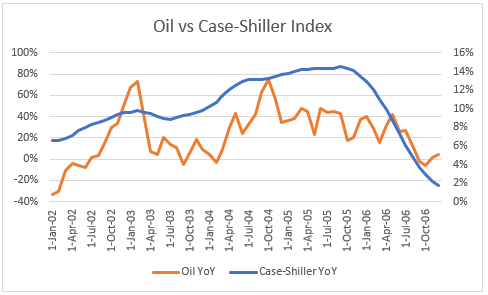
As long as housing was rising, an increase in oil meant a mortgage subsidy that more than offset the consumption tax.
- BP produces a nice annual Energy outlook with consumption forecasts by energy type, and also a useful (and much more detailed) Statistical Review of World Energy. Some other organizations do the same.
- Oil 101 was published just before fracking got big, so reviewers are divided on whether it’s out-of-date or timeless. I found it helpful as a quick primer on the industry.
- The Prize is a very fun history of the oil industry, full of fascinating stories. If you haven’t read it, you owe it to yourself: you’ll completely rethink the twentieth-century. World War Two, the Cold War, and the first Gulf War only make sense in light of oil. (Blaming Gulf War Two on oil is just fighting the last war, but for not-wanting-to-fight-wars. One way you know it’s wrong: when there’s a war motivated by oil, at least one side wins.)
- I read Crude Volatility after I wrote most of this, and was delighted to see that the author shares some of my theses. It’s a great look at the oil industry from the perspective of alternating periods of stability and extreme instability: the biggest players tend to band together to reduce price swings, but that gives free riders superior economics. Eventually, the bigger players are producing at capacity and can’t control prices any more, and then there’s a Minksy Moment where the cartel collapses and prices — and their volatility — explode higher.
- Oil is a bit outside my bailiwick, so if there’s some further reading you’d recommend, or if you’d like to follow up, email me.

 Byrne Hobart
Byrne Hobart